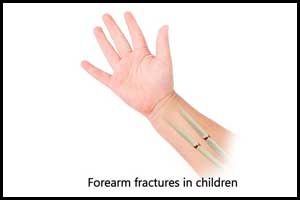- Home
- Editorial
- News
- Practice Guidelines
- Anesthesiology Guidelines
- Cancer Guidelines
- Cardiac Sciences Guidelines
- Critical Care Guidelines
- Dentistry Guidelines
- Dermatology Guidelines
- Diabetes and Endo Guidelines
- Diagnostics Guidelines
- ENT Guidelines
- Featured Practice Guidelines
- Gastroenterology Guidelines
- Geriatrics Guidelines
- Medicine Guidelines
- Nephrology Guidelines
- Neurosciences Guidelines
- Obs and Gynae Guidelines
- Ophthalmology Guidelines
- Orthopaedics Guidelines
- Paediatrics Guidelines
- Psychiatry Guidelines
- Pulmonology Guidelines
- Radiology Guidelines
- Surgery Guidelines
- Urology Guidelines
Vitamin D deficiency increases risk of severe forearm fractures in children

Forearm Fractures in children account for approximately 25 percent of all pediatric fractures in the U.S.In children vitamin D deficiency causes bone tenderness, dental deformities, impaired growth, increased bone fractures, muscle cramps, short stature, and skeletal deformities such as rickets.Dr.Pooya Hosseinzadeh with his colleagues conducted a study to find out the link between low vitamin D levels and the severity of fractures in children.They found that children who are vitamin D deficient have a greater risk of having more severe forearm fractures requiring surgical treatment.The findings of the new study have been presented at the 2018 Annual Meeting of the American Academy of Orthopaedic Surgeons (AAOS).
In this study, 100 children (ages 3 to 15; 65 percent male, 35 percent female) with low-energy forearm fractures were prospectively enrolled. Each participant filled out a questionnaire focusing on risk factors for vitamin D deficiency. The mean 25-hydroxyvitamin D (25[OH]D) concentration was 27.5 + 8.3 ng/ml.
The fractures were then categorized as requiring non-operative or operative management. The children's vitamin D status was based on measurement of 25(OH)D concentration obtained during the clinic visit, and was compared between the two fracture groups.
Among the results of the study:
- Using Endocrine Society guidelines, 21 percent of patients were vitamin D deficient (25(OH)D < 20 ng/ml) and 49 percent had vitamin D insufficiency (25(OH)D: 21 - 29 ng/ml).
- There was a dramatic difference in incidence rates of vitamin D deficiency between those treated surgically (50 percent) compared to those in the non-operative group (17 percent).
- Being vitamin D deficient was also associated with a greater risk of needing operative management (28.6 percent versus 7.6 percent non-operative).
- Being overweight/obese and nonwhite increased the likelihood of vitamin D deficiency.
- Seventy-five percent of children in the operative group were obese or overweight, compared to only 32 percent of children in the non-operative group.
- Patients requiring operative management were older than 10 years of age and had greater BMI than patients not requiring surgery.
"Not only are forearm fractures common in children, but so is vitamin D deficiency and insufficiency," said Pooya Hosseinzadeh, MD, assistant professor, Department of Orthopaedic Surgery at Washington University School of Medicine in St. Louis. "Knowing that vitamin D deficiency can lead to negative calcium balance, low bone mineral density and quality leading to compromised bone strength, it makes sense for patients to be more susceptible to fractures at lower impact load and more susceptible to greater severity when fractures do occur."
"This study provides an important takeaway for parents and pediatricians," explains Dr. Hosseinzadeh. "If a child does have a forearm fracture, we would encourage the physician to check the patient's vitamin D levels. The good news is that in most cases, children can reduce deficiency with a vitamin D supplement and increasing outdoor activity."

Disclaimer: This site is primarily intended for healthcare professionals. Any content/information on this website does not replace the advice of medical and/or health professionals and should not be construed as medical/diagnostic advice/endorsement or prescription. Use of this site is subject to our terms of use, privacy policy, advertisement policy. © 2020 Minerva Medical Treatment Pvt Ltd